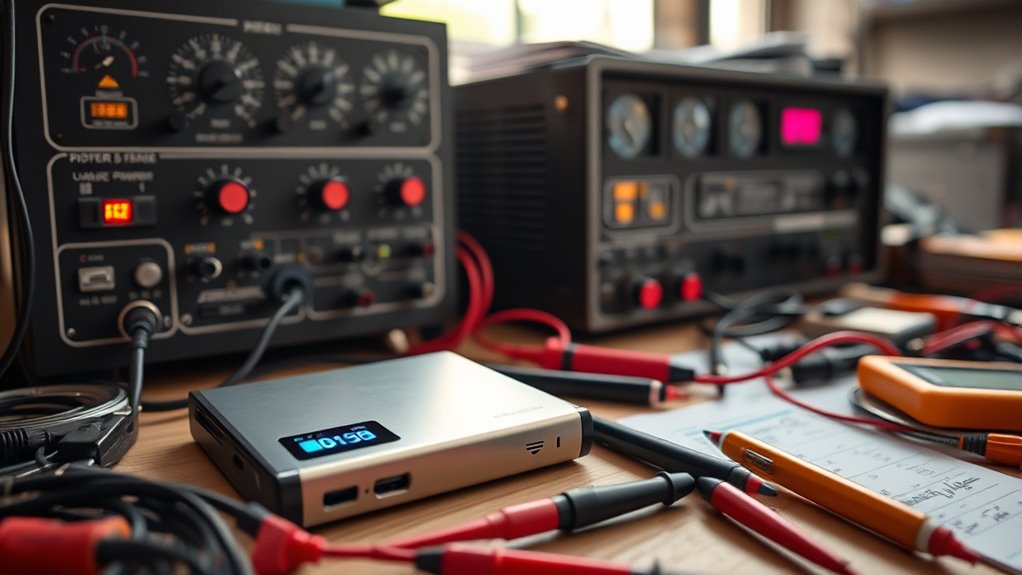To troubleshoot power banks and power stations effectively, you need to accurately calculate their capacity, matching device requirements with output ratings, and consider efficiency losses during charging and use. Always check voltage and current compatibility, and account for peak load capacities to prevent overloads. Monitoring battery health and understanding capacity decline can help prolong device life. Keep these calculations in mind to ensure safe, reliable power, and explore more to master each step.
Key Takeaways
- Always verify voltage and current ratings to ensure compatibility between power banks, power stations, and devices.
- Calculate total power needs by summing device wattages and include surge capacity for startup.
- Factor in charging efficiency losses (15-20%) to determine actual usable energy from power sources.
- Assess capacity in Wh or mAh to estimate run time and avoid power shortfalls during use.
- Monitor battery health and degradation to anticipate capacity loss and maintain reliable troubleshooting.
Calculating Power Capacity and Run Time

Understanding how much energy a power bank or power station can store is essential for planning your device usage. To accurately estimate run time, you need to contemplate the battery chemistry, which influences capacity and efficiency. Lithium-ion batteries are common, offering high energy density, but they require proper thermal management to prevent overheating. Overheating can degrade the battery and reduce performance, so manufacturers include cooling systems or thermal regulation features. Check the capacity in milliamp-hours (mAh) or watt-hours (Wh), which indicates how much energy the device can hold. Additionally, battery safety considerations are crucial when handling and charging large capacity power sources. By understanding these factors, you can better predict how long your power bank or station will keep your devices running, avoiding surprises when you need power most.
Determining Power Needs for Your Devices

How do you determine how much power your devices need from a power bank or station? First, check each device’s wattage or amperage rating, usually found on labels or in manuals. Add these numbers together to find your total power requirement. Consider device compatibility—verify your power source can handle the combined wattage safely. If you’re considering solar panel integration, factor in the input capacity to match your devices’ needs. This helps prevent overloading and ensures efficient charging. Remember, some devices draw more power during startup, so include a buffer in your calculations. Additionally, understanding inverter capacity is crucial to ensure your power system can handle peak loads without issues. By accurately evaluating these factors, you’ll choose a power bank or station that reliably supports your devices without risking damage or insufficient power.
Estimating Charging Efficiency and Losses
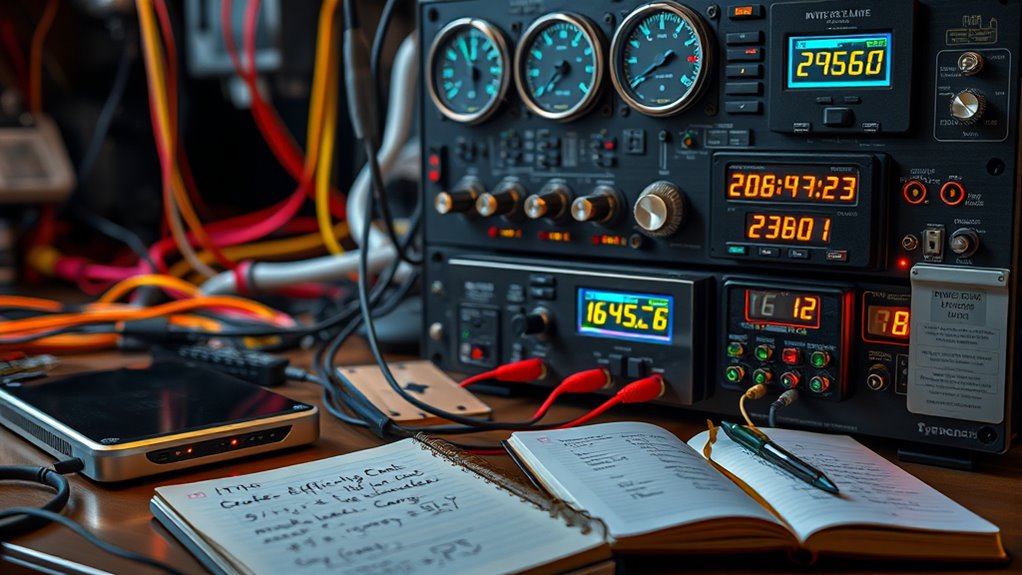
After calculating your devices’ total power needs, it’s important to account for charging efficiency and potential energy losses. When using a solar panel or wall socket, not all energy transferred makes it into your power bank or station. Charging efficiency varies depending on the source; for example, solar panels often have efficiencies between 15-20%, meaning a significant amount of energy is lost during conversion. Wall sockets tend to be more efficient but still experience losses from the charger’s internal circuitry. To estimate your actual usable energy, multiply your power needs by the efficiency percentage. This helps you determine the real amount of energy your power station or bank will store and deliver, ensuring you plan for those unavoidable losses and avoid overestimating your device’s runtime. Additionally, understanding the impact of automation in business can help optimize energy management systems for better efficiency.
Understanding Voltage and Current Compatibility
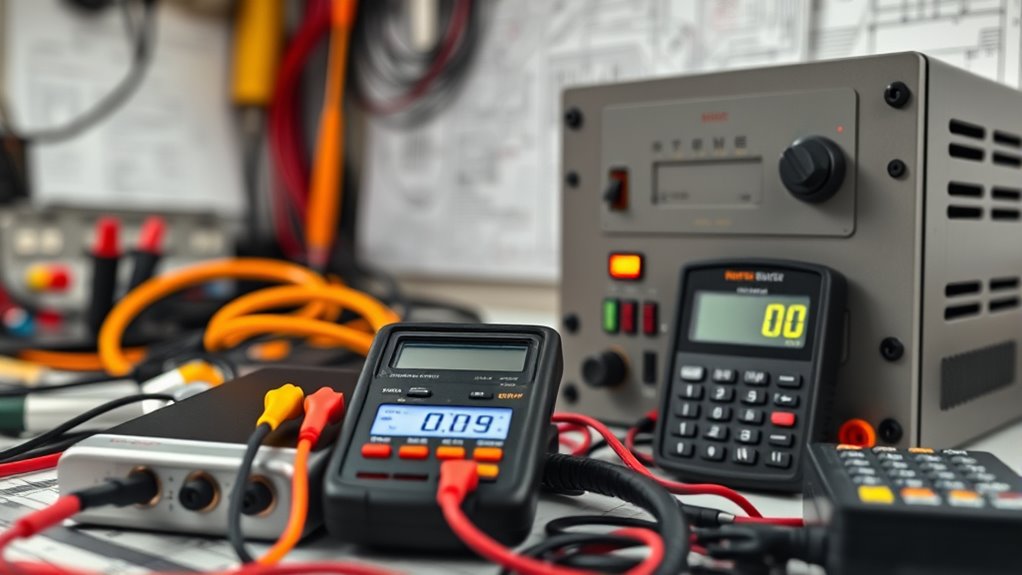
Ensuring your power bank or power station is compatible with your devices requires paying close attention to voltage and current ratings. Mismatched specs can lead to inefficient charging or damage. Check your device’s voltage and current needs against your power source’s outputs. For example, a solar panel’s voltage must match the input voltage of your power station for maximum efficiency. Additionally, inverter compatibility is vital when powering AC devices; ensure your inverter can handle the wattage and voltage demands. Here’s a quick comparison:
| Device Type | Voltage & Current Compatibility |
|---|---|
| Solar Panel | Match voltage and current for efficient energy transfer |
| Power Bank | Verify output voltage matches device requirements |
| Power Station Inverter | Confirm inverter supports device wattage and voltage |
Matching these specs guarantees safe, effective power delivery. Proper specification matching helps prevent potential damage and ensures optimal performance.
Troubleshooting Battery Degradation and Capacity Loss
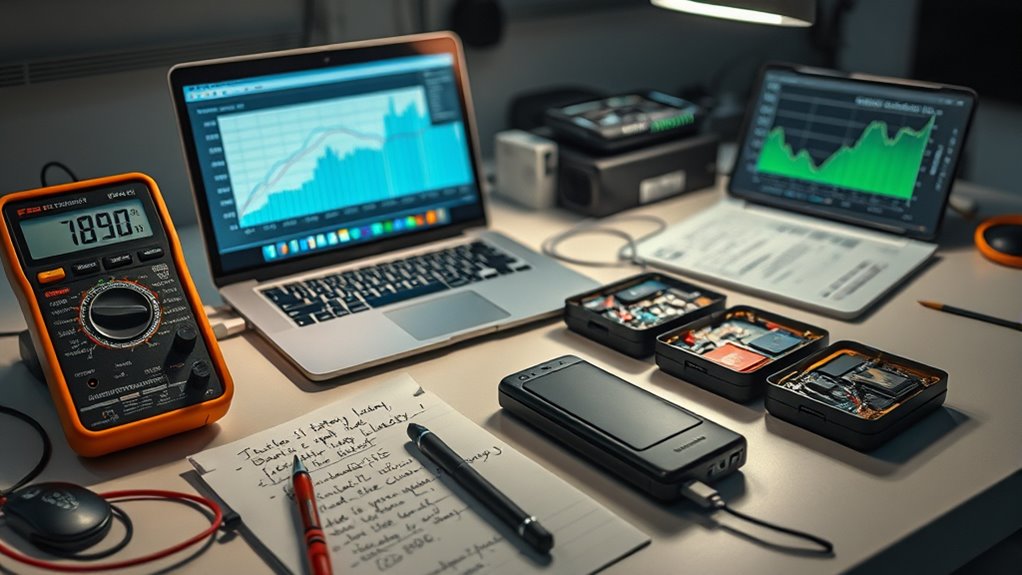
Battery degradation and capacity loss are common challenges that can diminish the performance of your power bank or power station over time. As batteries age, their ability to hold a charge decreases, leading to shorter usage times. To address this, check your device’s warranty policies—many manufacturers cover battery issues within a specific period, offering replacements or repairs. Proper battery recycling is essential at the end of your device’s lifespan; it guarantees safe disposal and can support the development of better, more durable batteries. If you notice a significant drop in capacity, consider whether the battery has reached its natural end-of-life or if environmental factors like extreme temperatures have accelerated degradation. Regularly monitoring your device’s performance helps you troubleshoot early and take appropriate action. Understanding the battery lifespan and how to extend it can help you maximize your device’s longevity and efficiency.
Analyzing Power Output and Peak Load Capabilities
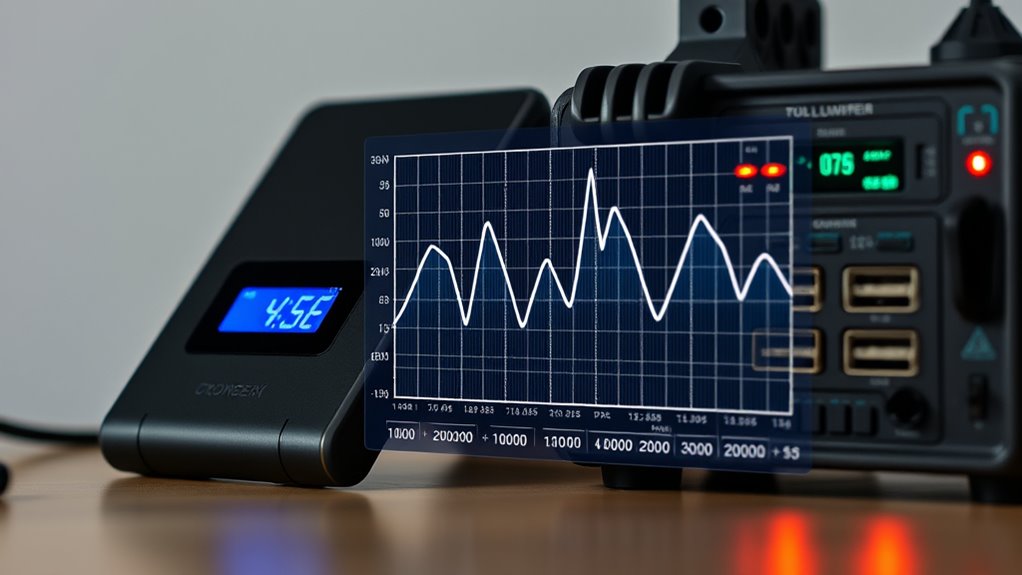
How can you determine if your power bank or power station can handle your device’s power demands? First, check the device’s peak power and continuous draw ratings, then compare them to your power source’s maximum output. Consider solar panel integration if you’re planning to recharge remotely; verify your panels can supply enough energy during peak loads. When selecting an inverter, choose one that matches your device’s startup surge and running wattage to avoid overloads. Peak load capabilities are essential because many devices draw more power temporarily upon startup. A power station with a higher peak load rating can handle these surges better. Proper analysis of power output, inverter selection, and solar compatibility ensures your setup can reliably support your power needs without interruptions. Additionally, understanding power efficiency can help you optimize your system’s performance and battery life over time.
Frequently Asked Questions
How Do Temperature Changes Affect Power Station Performance?
Temperature changes impact your power station’s performance by causing thermal expansion, which can strain components and reduce efficiency. As temperatures rise, you might experience voltage fluctuation, leading to unstable power output. Conversely, cold conditions can slow down chemical reactions in batteries, decreasing capacity. To maintain ideal performance, monitor temperature variations and guarantee your system is designed to handle thermal expansion and voltage fluctuations effectively.
What Safety Precautions Should I Follow During Troubleshooting?
When troubleshooting power stations, you should prioritize battery safety by wearing insulated gloves and eye protection. Always use proper troubleshooting tools, like a multimeter, to prevent accidental shorts or sparks. Confirm the power station is unplugged before inspecting internal components. Keep the workspace dry and well-ventilated, and avoid working on the device if you’re unsure of the procedure. Following these safety precautions protects you and the equipment.
Can Power Banks Be Used to Charge Power Stations?
Yes, you can use power banks for portable charging of power stations, but only if they’re compatible. Check the device compatibility and guarantee the power bank’s output matches the power station’s input requirements. Use the appropriate cables and avoid overloading. This way, you’ll safely extend your power station’s runtime and keep your devices charged without risking damage. Always verify compatibility before connecting for maximum safety and efficiency.
How Do I Identify Faulty Components in a Power Station?
You might spot a faulty capacitor or damaged circuit by inspecting visual signs like bulging or leaking components, which look like a volcano erupting. Use a multimeter to test for voltage irregularities or shorts. If a capacitor shows abnormal capacitance or a circuit is visibly burnt or scorched, you’ve probably found the culprit. Remember, addressing these issues promptly keeps your power station running smoothly, preventing catastrophic failures.
What Are Signs Indicating Imminent Battery Failure?
You’ll notice signs of imminent battery failure when your power station’s battery capacity diminishes faster than usual, and it struggles to hold a charge. If you observe frequent charging cycles, reduced runtime, or the battery becomes unusually hot or swollen, these are clear indicators. Keep an eye on these signs to prevent unexpected shutdowns, and consider replacing the battery before it fails completely.
Conclusion
By mastering calculations and clarifying capacities, you’ll confidently conquer charging challenges. Understanding voltage, verifying viability, and valuing efficiency ensures your devices stay powered and protected. With troubleshooting tips and thoughtful analysis, you’ll dodge disappointments and deliver dependable power. Remember, precise planning prevents problems, and diligent diagnostics drive durability. Keep these calculations current, and you’ll consistently stay connected, confident, and in control, no matter the power predicament. Power wisely, and progress persistently!
